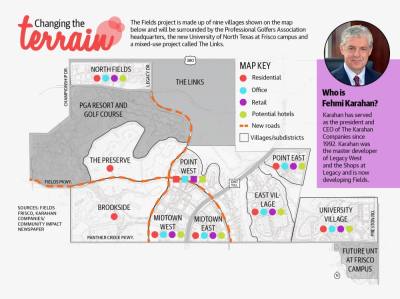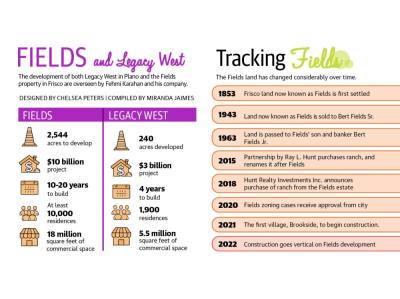“It was important for me to have ... the flexibility [to] create an extraordinary environment,” Karahan said.
The Legacy West project off Legacy Drive in Plano spans about 245 acres and put the city on the map as an employment center, former Plano Mayor Harry LaRosiliere said. The Fields project, also off Legacy Drive but in Frisco, will encompass 2,100 acres, Karahan said. That is more than 10 times larger than Legacy West.
At that size, the Fields has the potential to attract several major companies, generate billions of dollars of investment and create thousands of homes, jobs and new retail, roads and parks.
Visit Frisco Executive Director Marla Roe said she refers to the Fields project as a “city within a city” due to its scale.
Karahan described his work with Legacy West and The Shops at Legacy as comparable to winning “the Super Bowl several times.” He said he kept facing the question of, “What is next?” even though at the time he had no desire to do another project.
Then along came the Fields project. Its landscape—which includes sloped bluffs, creekbanks and rolling terrain not typically found in Frisco—is what drew Karahan in.
Ray L. Hunt, executive chair of Hunt Consolidated, and Chris Kleinert, co-CEO of Hunt Consolidated, were interested in purchasing the property. They reached out to Karahan to ask for his insight.
“I said, ‘Not only [should you] buy it, but I would be very interested in being your partner,’” Karahan said. “It’s a developer’s dream to be able to work in this scale.”
The road to development
The Fields land came into public scope after Hunt Realty Investments Inc. announced in August 2018 that it had purchased the former Headquarters Ranch from the estate of North Texas banker Bert Fields Jr. Hunt Realty purchased the 2,500-acre ranch site, now known as Fields, with investment partnerships from Chief Partners LP, CrossTie Capital Ltd., The Karahan Companies and the Fields estate. In 2020 KDC also joined the development team, which is being led by Hunt Realty and Karahan Companies.
In March 2020 Frisco City Council approved the rezoning to develop more than 2,100 acres of the Fields land located north of Panther Creek Parkway and bisected by the Dallas North Tollway. The other 400 acres were sold to the Professional Golfers Association headquarters in Frisco.
Karahan’s reputation with Legacy West and his involvement in the Fields project helped the city see the vision behind the development.
“Fehmi’s expertise and what he has done in his career is create an employment center along the [Dallas North Tollway] as well as entertainment venues, like with The Shops of Legacy and Legacy West,” Frisco’s Development Services Director John Lettelleir said. “That’s very important.”
The Fields development will help the city meet one of its goals of increasing its commercial tax base, Mayor Jeff Cheney said during the Frisco Chamber of Commerce State of the City Luncheon in June. The city has about $35 billion in taxable value, with about 70% from residential property and 30% from commercial property, Cheney said.
“Our long-term plan as a city is to get that to 50%-50%,” he said at the luncheon.
More commercial property contributing to the tax base allows the city to capture the revenue it needs to operate while removing more of the payment burden from residents. It helps keep the overall tax rate down, officials said.
The city’s public-private partnerships set to build out the northern part of Frisco will help with that, the mayor said. This includes the PGA project and The Link billion-dollar mixed-used development as well as Fields.
“We knew when we made this investment in the golf course that it would create a halo effect around this project, and it’s happening as we speak,” Cheney said.
The Fields vision
The Fields project will consist of nine subdistricts called villages. Running through these villages is Panther Creek, which will be enhanced to a “chain of lakes” as an additional amenity for the communities, per the website.
Development began to move forward following the 2020 city approvals. During these meetings, project owner FHQ Holdings LP requested up to 5,000 single-family units, 8,500 multifamily units, and 1,000 student housing units to meet the expected demand from the nearby University of North Texas at Frisco campus now under construction.
In exchange, Fields would designate a minimum 12% of open space for the property, but each subdistrict would have its own open space minimum as well. The development would also have no less than 12 neighborhood parks containing no less than 72 acres, ranging from half an acre to 7 acres.
To preserve the commercial development, the project also proposed a mixture of commercial spread over five of the subdistricts in certain areas and split between residential. This makes up about 1,000 acres, with 70% of it zoned for commercial, Karahan said.
The city agreed to these terms and had Karahan’s company bear responsibility for building Legacy Drive from Panther Creek to PGA Parkway, Fields Parkway from Teel Road to south of the Dallas North Tollway and the internal roadways within Fields, Karahan said. His team is working to finish the construction documents so they can start building the roads, he said.
The land, which made the project intriguing, also creates challenges because of the low waters and creek, necessitating bridges and moving dirt from high areas to low areas and vice-versa, Karahan said.
Building the roads is essential because it opens the opportunity for corporations, Karahan said.
The Fields area has good schools in both Frisco and Prosper ISDs, which contribute to the talent and workforce in the area, so companies will continue to look at North Texas, Karahan said. Fields will also have the flexibility in its commercial space to accommodate whatever style of campus those companies may need, he said.
“If somebody’s big and they want Toyota campus-style buildings, we can accommodate. Or if somebody wants one tall high-rise building, we could accommodate that,” he said.
The key for corporations is the roads, and the corporations will drive the rest of the development, Karahan said. Catching “big fish,” such as the Toyotas of the world, helps put the development process into high gear, he explained.
“It can be a 10-year project. It can be a 20-year project. Again it depends on our ability to attract companies to be there,” Karahan said.
The first village, called Brookside, is expected to be under construction this fall, he said, with the first homes delivered by the end of 2022.
In addition, the connecting road between the rest of Frisco and Fields—Legacy Drive—is under design, as is another road in this area, Fields Parkway. Both should be completed by summer or fall of 2023, Karahan said.
The roads also help deliver the people, said John Easterbrook, chief membership officer of the PGA of America. With more than 10,000 housing options, that opens more opportunities for people to come and enjoy the PGA of Frisco headquarters that is opening next year, he said.
“To have a neighbor like the Fields project—that’s going to be first-class—is going to put more eyeballs on [us],” Easterbrook said.
Reaping the rewards
The Fields zoning cases delivered on the council’s expectations on multiple fronts, Lettelleir said. The first being that the development will offer alternative residential styles that will likely hit different price points, he said.
He described it as “the first multigenerational neighborhood in Frisco,” where people will be able to move in and choose from apartments, townhomes for rent or purchase, and single-family homes that run from about $350,000 to luxury golf course estates.
“People have the opportunity to move within the neighborhood without having to move out,” Lettelleir said.
The second expectation was to provide more entertainment value to the city. That adds to the tax base and provides an amenity not just for residents but also for visitors, he said.
The additional businesses slated for Fields would probably generate convention business, and the development would also create a place where people want to be, Roe said. Fields will also be walkable, and that is something Frisco visitors desire, she said.
“It was really hard for us to compete against Legacy West or [The] Shops at Legacy because people could stay at a hotel and just get out and walk around,” she said. “Fields is going to lend a lot of this, since you’re looking at the same developer that did Legacy West.”







